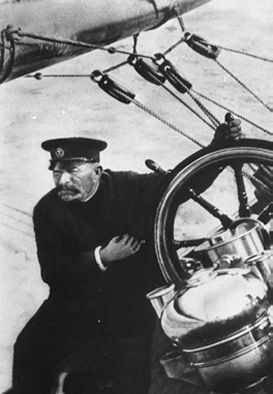Yves GARY Affichages : 5702
Catégorie : SKIPPERS & EQUIPIERS
 THE ILLUSTRATED LONDON NEWS, OCT 3, 1901 (races not finished)
THE ILLUSTRATED LONDON NEWS, OCT 3, 1901 (races not finished)Le capitaine Sycamore et le Capitaine Barr sont les hommes du jour et les hommes de la semaine, même s'ils n'ont pas encore été déclarés «hommes de l’année». Leurs noms ont remplacé progressivement dans le langage populaire les noms de Shamrock II et de Columbia, et nous avons eu un duel ...
... dans les eaux de New York moins peut-être entre constructeurs ou architectes qu'entre skippers. «Le capitaine Sycamore était en tête ici» ou «le capitaine Barr menait là» est le vocabulaire commun utilisé pour la course de yacht la plus commentée encore jamais naviguée. Le capitaine Sycamore a le mérite d'être non seulement un excellent capitaine, mais aussi un Écossais, et quelqu'un qui avait des activités municipales à terre avant qu'il ne prenne la mer. Le fait que le capitaine Barr est lui-même porteur d'un nom bien connu au nord de la Tweed semble indiquer que les responsables de la course ont décidé de choisir un Écossais pour affronter un Écossais. Ce choix offre l'avantage que, si le capitaine Sycamore ou le capitaine Barr doit perdre, c'est l’Écosse qui doit gagner.
Lieutenant Edward Isaac Sycamore, RNVRBy Commander David Frost Royal Navy. |
||
| Captain Sycamore, my great grandfather, was born on 24 August 1855 in Chelmsford, the main town in Essex County. Syc, as he was usually known, had no formal qualifications of any sort and, as he started work as a fisherman at the age of 12, he wouldn’t have had much education. His mother died when he was six and his father abandoned the family, so Syc was brought up by his maternal grandparents. Aged seven he was paid 3d per day to work on his grandfather’s farm. He started in yachting with the Marquis of Ailsa in 1875 and was launched on a career that was to make him one of the world’s best known racing yacht skippers between 1890 and 1929. His career included two America’s Cups and lengthy spells in charge of Sir Thomas Lipton’s 23 metre Shamrock.  |
He also skippered the 19 metre Mariquita for A K Stothert. She was rebuilt a few years ago and I had the pleasure of a sail in her in the Solent. Among the owners for whom he worked in the 1890s was Rear Admiral the Hon. Victor Montague, he of the eponymous whaler, which will be familiar to many older Naval members. Syc was poached by Lord Dunraven as skipper for the America’s Cup challenge of 1895. He evidently parted from Montague on good terms as the latter presented him with a silver watch. Also in my possession is an engraved stop watch he was given by Admiral Lord Charles Beresford, then CinC Channel Fleet. I have recently inherited all Syc’s papers from 1880-1930. There’s even correspondence about prize money which I didn’t realise was still payable during the First World War. Syc’s early wartime experiences were unfortunate. In 1914 he had command of the German-owned 15 metre Isabel Alexander. Along with the Kaiser’s yacht Meteor they were being towed by a torpedo boat to England for Cowes week when war broke out. Towed back to Germany he and his crew were interned for a short while before being repatriated via Denmark. Such generosity of spirit may have been due to him being well known to the Kaiser, whose yacht he regularly beat. Sacred Cowes reports his appearance before the Admiralty Interview Board thus: “What,” asked their Lordships, “do you know about navigation?” “I guarantee to take any vessel you like to give me from Dover to Rosyth in thick weather quicker than any of you gentlemen sitting round the table,” Sycamore told them, with such conviction that they gave him a commission. |
 The survival of ML logs is patchy and there are none for ML350 or his later command ML5 for the period he was in them. That for ML350 for the three months prior to his joining reveals the ship was on mundane patrols in the Irish Sea. She later operated from the seaplane base at Newlyn, and ML5 spent most of her time at Dundee. Syc became a Captain RFA on 1 April 1918 and was not demobbed until 13 September 1919, by which time he was well past his 64th birthday. He resumed his yachting career and was still skipper of Shamrock on his 74th birthday in 1929. He died on 9 April 1930. My great grandmother survived him by 32 years and lived long enough to receive a telegram from the Queen. |

Lieutenant Edward Isaac Sycamore, RNVR - By Commander David Frost Royal Navy. - Forces Pension Society
- CUP RACING SKIPPERS - The Ottawa Free Trader - 6 sept. 1901
- Captain Sycamore and Captain Barr - THE ILLUSTRATED LONDON NEWS, OCT 3, 1901
- VALKYRIE'S SKIPPER HERE - The New York Times, July 17, 1900
- [PDF] The history of a legend - Yacht Mariquita
